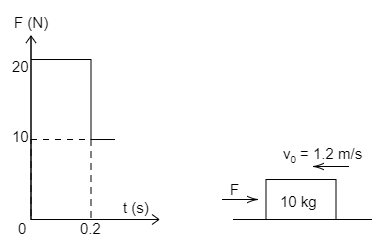Question
Question: . The \(10\) Kg block is moving to the left with a speed of \(1.2\,m{s^{ - 1}}\)at time \(t = 0\). A...
. The 10 Kg block is moving to the left with a speed of 1.2ms−1at time t=0. A force F is applied as shown in the graph. After 0.2sthe force continues at the 10Nlevel. If the coefficient of Kinetic friction is μk=0.2. Determine the time t at which the block comes to stop (g=10ms−2)
(A) 0.333s
(B) 0.526s
(C) 0.165s
(D) None of the above.

Solution
Hint In the question, kinetic friction, mass of the block is given. By using the formula of the equations of motion, we get the value of the time t at which the block comes to stop has been calculated.
Formula used:
The expression for finding the time is,
v=u+at
Where,
v be the final velocity, u be the initial velocity, a be the acceleration due to the gravity and t be the time.
Complete step by step solution:
Given that
Kinetic friction, μk=0.2
Mass of the block m=10kg
Acceleration due to gravity g=10ms−2
If the block moves left, frictional force acts on the block. So, the frictional force acts towards right which means it moves towards the direction of the external force applied.
Friction force f=μkmg
Substitute the known values in the above equation, we get
f=0.2×10×10
Performing the arithmetic operations in the above equation, we get
f=20N
Force is applied for the duration of 0⩽t⩽0.2s
External force F=20N
Total force acting on the block F′=F+f
Substitute the known values in the above equation, we get
F′=20+20
Perform the arithmetic operation, we get
F′=40N
Retardation of block a=−mF′
Substitute the known values in the above equation, we get
a=10−40
Simplify the above equation, we get
a=−4ms−2
Velocity of the block after 0.2s, we get
v=u+at Here, t=0.2s
Substitute the known values in the above equation, we get
v=1.2−4×0.2
Simplify the above equation we get
v=0.4ms−2(towards left)
For the duration above t⩾0.2s
External force F=10N
Total force acting on the block F′=F+f
F′=10+20
Perform the arithmetic operation, we get
F′=30N
Retardation of the block a=−mF′
a=10−30
Simplify the above equation, we get
a=−3ms−2
Let the time reaches, after it comes to rest
So therefore v′=0
v′=u+at′
Substitute the known values in the above equation, we get
0=0.4−3t′
t′=0.133s
Therefore, the total time after which the block comes to rest T=t+t′
T=0.2+0.133
T=0.333s.
Therefore, the time after it comes to stop is 0.333s.
Hence, from the above options option A is correct.
Note: In the question the value of the time is given. By finding the difference of the before and after timing. Substitute those values in the equation of motions and find the difference of the value of the time, after it comes to rest. Then we get the value of the time.
